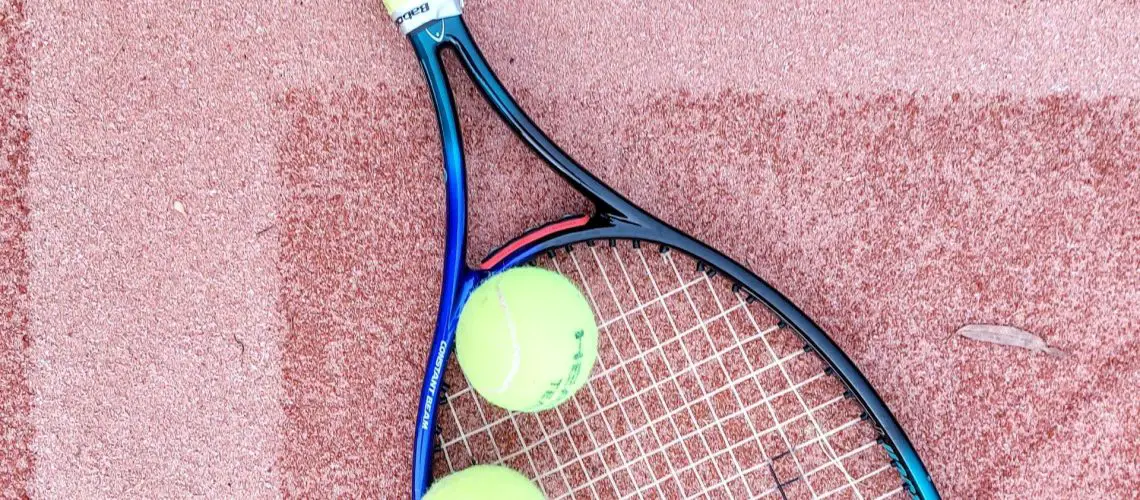We may earn money or products from the companies mentioned in this post.
Introduction

Welcome to the world of racquet sports! Whether you’re a seasoned player or just starting out, there’s something exhilarating about wielding a racquet and sending that ball flying across the court In this article, we’ll be delving into the exciting realm of table tennis and comparing it with other popular racquet sports such as tennis, badminton, and squash
A Brief Overview
Let’s begin by exploring the history and origins of table tennis This fast-paced indoor sport originated in Victorian England during the late 19th century Initially known as “ping pong,” it quickly gained popularity as a leisure activity in homes around Europe Today, table tennis has evolved into a highly competitive sport played at both recreational and professional levels
Now, let’s turn our attention to some other well-known racquet sports:
-
Tennis:
Known for its elegant style and demanding physicality, tennis is one of the most widely played racquet sports worldwide It originated in France during the 12th century and has since captivated players with its strategic gameplay on various surfaces like grass, clay, or hard courts -
Badminton:
Originating from ancient civilizations in Asia, badminton is a dynamic sport that requires agility, speed, and precision Played with lightweight rackets and shuttlecocks (feathers or synthetic), it can be enjoyed both indoors and outdoors -
Squash:
This high-intensity sport traces its roots back to 19th-century England Squash is played within four walls on an enclosed court using hollow rubber balls The objective is to outmaneuver your opponent by hitting shots against the front wall while utilizing angles and strategies
The Purpose of Comparison
Now that we have a brief understanding of the different racquet sports, you may wonder why we’re comparing table tennis with these other sports Well, the purpose is to highlight the unique aspects and characteristics of each sport, shedding light on their similarities and differences By doing so, we can gain a deeper appreciation for the nuances of these games and perhaps inspire you to explore new sporting endeavors or enhance your skills in your favorite sport
Equipment and Playing Area Differences

When it comes to table tennis, the equipment used can greatly impact the game Let’s take a look at the key differences in table tennis equipment:
Table Tennis Equipment
-
Paddles:
Paddles, also known as rackets or bats, come in various sizes, shapes, and materials The size of the paddle affects the player’s grip and maneuverability Different shapes offer unique advantages for specific playing styles Materials like wood, carbon fiber, or rubber can affect spin and control Additionally, players can choose from different grip styles based on personal preference -
Balls:
Table tennis balls have specific weight, size, and material requirements The weight and size of the ball impact its bounce and speed when played Balls are typically made of celluloid or plastic materials -
Table:
The table itself has specific dimensions, markings, net height, and tension requirements Standard tables are 9 feet long by 5 feet wide with a height of about 25 feet Proper markings ensure fair play during matches while net height and tension contribute to consistent gameplay
In addition to table tennis equipment variations, other racquet sports like tennis, badminton, and squash also have their own unique characteristics:
Other Racquet Sports Equipment Variations
-
Racquets:
Racquets vary in size, shape, and materials used for strings/frame/grip tape/handles across different sports - a) Tennis Racquets: Tennis racquets come in various sizes with different string patterns that affect power and control The frame is typically made of materials like graphite or titanium, ensuring durability and flexibility
- b) Badminton Racquets: Badminton racquets are lighter and have a smaller head compared to tennis racquets The strings are usually made of nylon or synthetic materials, providing excellent control for fast-paced rallies
- c) Squash Racquets: Squash racquets are uniquely designed to withstand the demands of the game They have a smaller head size and a thicker frame to handle the intense hitting involved in squash matches
-
Balls/Shuttlecocks Specifications:
Each racquet sport has specific ball or shuttlecock specifications that contribute to gameplay dynamics - a) Tennis Balls: Tennis balls vary in size, weight, and material Their felt covering allows players to generate spin and control during rallies on the court
- b) Badminton Shuttlecocks: Badminton shuttlecocks are feathered projectiles that come in different speeds, indicated by their weight These shuttlecocks ensure both precision and speed on the badminton court
- c) Squash Balls: Squash balls have varying levels of bounce based on their color-coded dots Different dot colors indicate different ball types suitable for various skill levels and playing conditions
Understanding these equipment differences is crucial for players looking to excel in each respective sport Whether it’s table tennis, tennis, badminton, or squash, having the right equipment can make all the difference on the playing field!
Rules and Regulations Unique to Table Tennis Compared to Other Racquet Sports

Table tennis, also known as ping pong, has its own set of rules and regulations that distinguish it from other racquet sports In this article, we will explore the basic rules overview in table tennis, compare them to the rules in other racket sports like tennis, badminton, and squash, and highlight the unique aspects of table tennis
Basic Rules Overview in Table Tennis
In table tennis, serving, receiving, and scoring are key elements that define the game Serve requirements include following specific rules on doubles play and let serve situations Additionally, there are service order regulations to ensure fairness and equal opportunities for both players or teams
When it comes to receiving, there are rules regarding double hit scenarios and corrections during rallies These guidelines ensure that players maintain proper technique while returning shots and prevent any unfair advantages
Comparison to the Rules in Other Racket Sports: Tennis
Tennis shares some similarities with table tennis but also has notable differences in its rules Serving, receiving, scoring systems (including deuce), singles versus doubles format, challenges system, and umpire interventions are just a few areas where the two sports diverge
In tennis matches, players have the opportunity to challenge line calls using technology like Hawkeye Umpires play a more prominent role in enforcing rules such as foot faults or code violations that may affect gameplay The concept of deuce is another aspect unique to tennis scoring systems
Comparison to the Rules in Other Racket Sports: Badminton
Badminton is another popular racquet sport with distinct rule differences when compared to table tennis Similarities lie in serving/receiving/scoring aspects, but badminton employs a rally point system, which means a point is scored on every play, regardless of who served
Like table tennis, badminton has both singles and doubles formats However, the in or out calls and challenges system differs between the two sports In badminton, players rely on their judgment and that of the umpire to determine whether shots land within the boundaries
Comparison to the Rules in Other Racket Sports: Squash
Squash, another racquet sport with its own set of rules, has notable differences when compared to table tennis Serving, receiving, scoring (including let situations), singles versus doubles format, and in or out calls/challenges are areas where squash diverges from table tennis
In squash matches, players must ensure their serves land within specific zones on the court The let rule comes into play when there is interference during a shot attempt Additionally, similar to other racket sports discussed above, squash can be played both in singles and doubles format
These unique rules and regulations make table tennis stand out among other racquet sports Understanding these distinctions enhances one’s appreciation for the intricacies of each game and enables players to excel in their chosen sport
Tactics, Skills, and Physical Fitness Differences

When it comes to table tennis, the game is all about quick reflexes, precision shots, and strategic gameplay Players employ a variety of tactics and techniques to outwit their opponents On the offensive side, players use powerful loops, drives, smashes, and flicks to gain an advantage Defensively, they rely on blocks, chops, and lobs to counter their opponent’s attacks Additionally, spin variations such as topspin, backspin, and sidespin play a crucial role in manipulating the ball’s trajectory
In comparison to other racquet sports like tennis or badminton, there are distinct differences in tactics and techniques In tennis, players utilize ground strokes like forehands and backhands along with volleys at the net They also incorporate approach shots and varied spins in their arsenal Tennis players often strategize between baseline play or net play depending on the situation
Meanwhile in badminton, tactics revolve around clear shots for gaining distance or dropping the shuttle close to the net Players also aim for powerful smashes that can turn the tide of a match Additionally,
speed
, agility,
explosiveness
,
footwork
,
and deceptive shots
are essential skills that enable success on the badminton court
Squash brings its own unique set of tactics into play with drives,
drops,
volleys,
lobs,
boasts,
nick shots,
court coverage strategies,. Squash players must nimbly move across the court while executing precise shots to outmaneuver their opponents
-
Tactics
,
Skills
,
and Physical Fitness Differences:
In table tennis, players employ a range of offensive and defensive tactics Offensive play involves using loops, drives, smashes, and flicks to overpower the opponent On the defensive end, players rely on blocks, chops, and lobs to counter their opponent’s attacks Spin variations like topspin, backspin, and sidespin are also crucial in manipulating the ball’s trajectory
Tennis players utilize ground strokes such as forehands and backhands along with volleys at the net They also employ approach shots and varied spins to outwit their opponents Strategies can differ between baseline play or net play depending on the situation
In badminton, tactics revolve around clear shots for gaining distance or dropping the shuttle close to the net Players aim for powerful smashes that can turn the tide of a match Speed, agility, explosiveness, footwork,and deceptive shots are key skills in this fast-paced sport
Squash requires players to execute drives,drops,volleys,,lobs,,boasts,nick shots,court coverage strategies while swiftly moving across the court Skillful shot placement combined with speed,
, agility
, stamina
,
and mental toughness
,
are essential for success in this intense racquet sport
Useful Links

Mobile Racquet Sports – ennisphysioclinic.ie
A Conversation on the Overlap Between Racquet Sports
Does playing other racket sports hinder or help your tennis …
How Is Table Tennis Different From Other … – Ping Pong Tips
Olympics: Racket Sports
badminton or racquetball or squash or table tennis or tennis?
How Is Table Tennis Different From Other Racquet Sports?
List of Racket/Racquet Sports
10 most popular and played racket sports in the world
Tennis & Racquet Courts
Developing Racquet Sport Skills
Tennis, badminton, paddle, what is the origin of racket …
Which Sports are Similar to Tennis?
Analysis of Specific Physical Fitness in High-Level Table …
RacketPal: Find Nearby Players – Apps on Google Play
Coming to Pickleball from a Racquet Sports … – YouTube
List of racket sports
How is Badminton Unlike Other Racquet Sports?
Do You Have These Essential Equipment For Racket Sports






